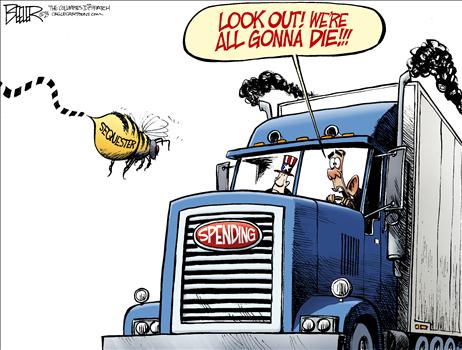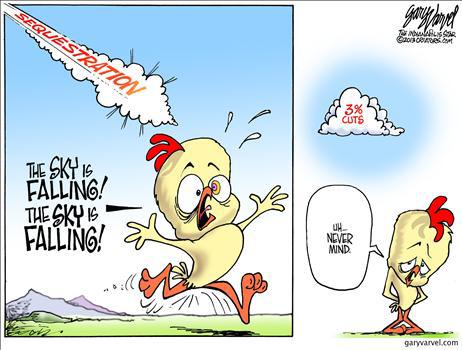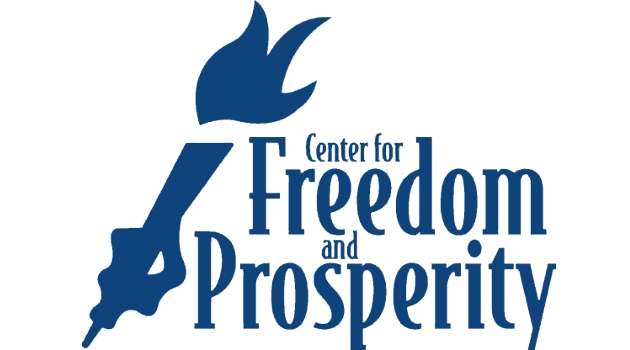I shared a couple of amusing sequester cartoons the other day, and I’ve previously written about the absurdity of anti-sequester hysteria in Washington when all it means is that the federal budget will grow by $2.4 trillion over the next 10 years rather than $2.5 trillion.
This Nate Beeler cartoon effectively captures the mindset of Washington’s big spenders.

Let’s take a serious look at this topic.
George Will is appropriately disgusted by the antics of the political class. Here’s some of his column on the topic.
The sequester has forced liberals to clarify their conviction that whatever the government’s size is at any moment, it is the bare minimum necessary to forestall intolerable suffering. At his unintentionally hilarious hysteria session Tuesday, Obama said: The sequester’s “meat-cleaver approach” of “severe,” “arbitrary” and “brutal” cuts will “eviscerate” education, energy and medical research spending. “And already, the threat of these cuts has forced the Navy to delay an aircraft carrier that was supposed to deploy to the Persian Gulf.”
Will elaborates on the Navy’s shameful stunt.
“Forced”? The Navy did indeed cite the sequester when delaying deployment of the USS Truman. …the Navy is saying it cannot find cuts to programs or deployments less essential than the Truman deployment. The Navy’s participation in the political campaign to pressure Congress into unraveling the sequester is crude, obvious and shameful, and it should earn the Navy’s budget especially skeptical scrutiny by Congress. The Defense Department’s civilian employment has grown 17 percent since 2002. In 2012, defense spending on civilian personnel was 21 percent higher than in 2002. And the Truman must stay in Norfolk? This is, strictly speaking, unbelievable.
Will also comments on the Keynesian economic theory being used to fight against sequestration.
Obama, who believes government spends money more constructively than do those who earn it, warns that the sequester’s budgetary nicks, amounting to one-half of 1 percent of gross domestic product, will derail the economy. A similar jeremiad was heard in 1943 when economist Paul Samuelson, whose Keynesian assumptions have trickled down to Obama, said postwar cuts in government would mean “the greatest period of unemployment and industrial dislocation which any economy has ever faced.” Federal spending did indeed shrink an enormous 40 percent in one year. And the economy boomed.
Amen. I’ve already cited a Cato study on this topic, which shows that the Keynesians were wildly wrong in their predictions of post-war economic collapse.
And the Wall Street Journal also has opined on this topic, showing not only that lawmakers wisely rejected another round of Keynesian foolishness, but also that post-war tax cuts were one of the reasons why the economy quickly rebounded.
Let’s close with some more mockery of the clowns in Washington.
This Gary Varvel cartoon shows what’s happening, though I’ve would have drawn Chicken Little to resemble Obama.

But what about the second frame of the cartoon? If the sequester happens, will the statists be forced to admit that they were creating false fears in hopes of protecting their spots at the federal trough?
As reported in the Washington Post, one of them is very worried about this possible outcome.
“…The bad news is, the world doesn’t end March 2,” said Emily Holubowich, a Washington health-care lobbyist who leads a coalition of 3,000 nonprofit groups fighting the cuts. “The worst-case scenario for us is the sequester hits and nothing bad really happens. And Republicans say: See, that wasn’t so bad.”
Since the sequester takes effect on March 1, we’ll soon find out.
Some bureaucracies will deliberately try to make the sequester as inconvenient and painful as possible for the American people. As I said in this Larry Kudlow interview, the heads of those agencies should be fired.
Of course, Obama will probably try to reward them, but those who favor responsible fiscal policy should do everything possible to expose the shameful game being played by these political hacks.

